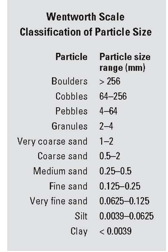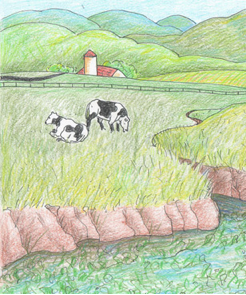
Barbara Tinker
Water carries rock and organic material of all sizes. The large rocks and particles fall out when the water slows. The finer, undissolved particles that make the water turbid – cloudy or murky - are our concern here.
Pure water is clear, and light can pass through it easily. If there are particles suspended in the water, however, the light scatters off those particles and makes the water appear murky.
So turbidity testing is to see how clear the water is, how dense are the insoluable particles that interfere with the passing of light. - Consuelo Rogers, Hawaii
The particles also provide surfaces on which potentially dangerous bacteria can grow. When turbidity levels rise in public drinking water supplies, chlorine must be used to kill the bacteria hiding on the particles.
Turbidity is caused by substances that have not dissolved in water, such as clay and other soil particles, algae, plankton, and microorganisms. These particles will float suspended in the water, but after several hours they fall to the bottom. Some particles may continue to float in the water, while others have settled. This mixture of water and floating particles is called a suspension.
Dissolved particles are surrounded by water molecules, so you cannot see the particles at all. But, although you may not be able to see the particles individually, together they give the water a hazy, murky appearance. These particles can be separated from the water by filtration, which leaves particles on the filter paper.
|
The Wentworth Scale classifies water particles as in the chart below.
 Suspensions are formed by particles in the size range 0.004 to 0.065 mm, silts. A particle of 0.065 mm will take about 4 seconds to sink 1 cm in still fresh water, whereas a particle of 0.004 mm will take about 1 hour to sink 1 cm in the same water. Particles sink more slowly in seawater because it is denser than freshwater. Furthermore, silt particles in seawater tend to clump together and fall more quickly. This also occurs in any body of water with a high concentration of silt. Suspensions are formed by particles in the size range 0.004 to 0.065 mm, silts. A particle of 0.065 mm will take about 4 seconds to sink 1 cm in still fresh water, whereas a particle of 0.004 mm will take about 1 hour to sink 1 cm in the same water. Particles sink more slowly in seawater because it is denser than freshwater. Furthermore, silt particles in seawater tend to clump together and fall more quickly. This also occurs in any body of water with a high concentration of silt.
In rivers or estuaries with strong current flows, suspensions can be created from even larger particles. The flowing water keeps the particles in motion so they do not fall out as quickly. These larger particles rapidly settle to the bottom when the current slows down.
Once particles settle on the bottom, only fast flowing water can pick them up again. Sand particles in the 0.2–0.5 mm range can move across the bottom with a flow of 20 cm per second. To give you an idea of scale, big rivers like the Hudson River or the Savannah River flow at 100 cm per second in the middle of the water current. This flow is greatly reduced toward the edges and the river bottom. These rivers tend to be deeper in the middle because soil along the bottom is moved by swift currents. Surprisingly, it takes a faster current to lift the finest silt than to lift the sand because fine silt particles tend to compact and therefore resist water flow. A uniform sediment of 0.002 mm particles requires a flow of 100 cm per second in order to suspend the particles. This high rate of flow is usually only seen in full flood conditions.
|
More causes of turbidity
 Turbidity is often caused by particles entering the water through various natural and human processes. In arid regions, streams and rivers flow over sandstone and other easily eroded materials. This adds large amounts of suspended particles to the water. In contrast, oceans are very clear and have very low turbidity because of their depth and large size. After heavy rain, most water bodies have increased turbidity caused by the increase in surface runoff.
Human activity near and around a body of water can create severe erosion and runoff, resulting in highly turbid water. These activities include grazing, cultivating, construction and building, logging, and applying sand to roadways during the winter.
jbp
Other activities cause turbidity as a secondary effect. For example, when treated waste and other organic nutrients are dumped into the water, algae and plankton populations increase dramatically, causing high turbidity. |
The effect of turbidity on life
Turbidity affects water ecosystems in many ways. Since light scatters off suspended particles and is therefore prevented from traveling deep into the water, turbidity limits photosynthesis and lowers the amount of dissolved oxygen available to other organisms.
Suspended particles also absorb heat, increasing the temperature of the water and decreasing the amount of dissolved gases that the water can hold. Silt, algae, and other particles can clog fish gills, smother eggs, and reduce the habitats available to macro-invertebrates. Harmful bacteria and other microorganisms can breed and grow on the suspended particles and pollutants, making the water unsafe to drink. |



 Suspensions are formed by particles in the size range 0.004 to 0.065 mm, silts. A particle of 0.065 mm will take about 4 seconds to sink 1 cm in still fresh water, whereas a particle of 0.004 mm will take about 1 hour to sink 1 cm in the same water. Particles sink more slowly in seawater because it is denser than freshwater. Furthermore, silt particles in seawater tend to clump together and fall more quickly. This also occurs in any body of water with a high concentration of silt.
Suspensions are formed by particles in the size range 0.004 to 0.065 mm, silts. A particle of 0.065 mm will take about 4 seconds to sink 1 cm in still fresh water, whereas a particle of 0.004 mm will take about 1 hour to sink 1 cm in the same water. Particles sink more slowly in seawater because it is denser than freshwater. Furthermore, silt particles in seawater tend to clump together and fall more quickly. This also occurs in any body of water with a high concentration of silt.